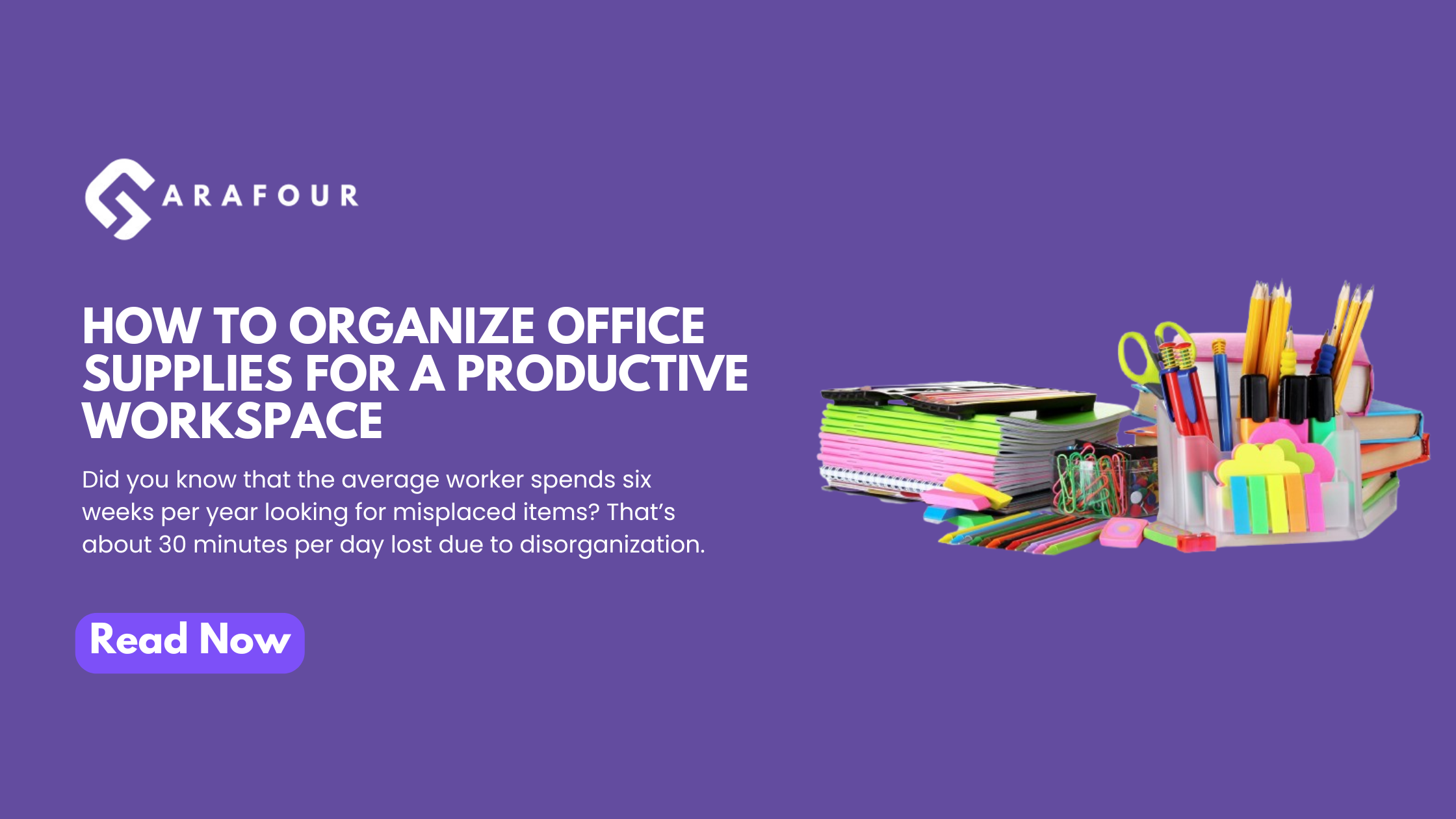How to Organize Office Supplies for a Productive Workspace
Did you know that the average worker spends six weeks per year looking for misplaced items? That’s about 30 minutes per day lost due to disorganization. A cluttered workspace not only affects productivity but also increases stress and financial losses. Businesses spend an estimated $400 per employee annually on replacing lost or misplaced office supplies.
Picture this: It’s 3 PM, and you’re scrambling to print a report for a meeting. But where’s the stapler? You rifle through drawers overflowing with sticky notes, dried-up pens, and mystery cables. Sound familiar? Disorganized office supplies aren’t just annoying—they waste time, drain productivity, and even cost money (ever reordered printer ink you already had?).
Whether you work from home or in an office, organizing office supplies is an easy yet efficient method of enhancing efficiency. A properly organized workspace increases concentration, accelerates work, and makes a professional impression on clients.
This guide outlines a step-by-step approach to decluttering, categorizing, and storing office supplies effectively.
Key Benefits of Organizing Office Supplies
Before diving into the process, here are a few reasons why organizing your office supplies is important:
- Increases Productivity – Employees in an organized workspace are 77% more productive than those in cluttered environments (Forbes).
- Reduces Stress – A study by Princeton University found that clutter negatively impacts focus and mental clarity.
- Saves Money – Companies waste up to $89 billion per year on misplaced office supplies and unnecessary reorders (Brother International Study).
- Enhances Efficiency – When everything has a designated place, tasks can be completed faster with fewer distractions.
- Creates a Professional Image – A tidy office leaves a positive impression on clients, employees, and visitors.

How to Organize Office Supplies?
Here is the step-by-step guide on how to organize office supplies:
Step 1: Assess Your Current Setup
Before buying organizers, start by evaluating your existing supplies.
| Task | Actions |
| Take Inventory | Empty drawers, shelves, and cabinets. Categorize supplies (writing tools, paper products, tech accessories, desk essentials). Discard expired items. |
| Identify Pain Points | Ask: Are supplies scattered? Do you overstock items? Is there a cluttered “junk drawer”? |
Step 2: Declutter Ruthlessly
Keep only what you use and need.
| Category | Action | Example |
| Keep | Store frequently used items | Pens, notebooks, sticky notes |
| Donate | Give away gently used supplies | Extra staplers, unopened notebooks |
| Recycle | Dispose of recyclable materials | Empty ink cartridges, shredded paper |
| Trash | Get rid of broken or dried-up items | Dried-out pens, expired products |
Pro Tip: Apply the 20/80 Rule: You use 20% of your supplies 80% of the time. If you have 50 pens but only use 10, donate the extras.
Step 3: Categorize Strategically
Group supplies based on function, not type.
| Category | Examples | Storage Placement |
| Daily Use | Pens, sticky notes, notebook | Within arm’s reach on your desk |
| Weekly Use | Printer paper, staples, paper clips | Nearby drawers |
| Rarely Used | Bulk purchases, holiday stationery | Storage closet |
Create Storage Zones:
- Desk Zone → Essentials (pens, notepads, scissors)
- Storage Zone → Overstock or bulk supplies
- Shared Zone → Community staplers, printers
Step 4: Choose the Right Storage Solutions
Select the best storage methods based on your budget and space.
| Type | Storage Solution | Best For |
| Budget-Friendly | Drawer dividers, pegboards, mason jars | Small supplies like paper clips, markers |
| Premium Solutions | Rolling carts, transparent bins, modular shelving | Bulk or shared office supplies |
| DIY Hacks | Binder clip cable organizers, over-the-door shoe organizers | Tech accessories, cables |
Step 5: Label Everything
Labels help maintain organization and reduce search time.
| Labeling Tool | Use Case |
| Chalkboard Labels | Reusable and stylish for storage bins |
| Color-Coded Stickers | Red = urgent supplies, Green = daily use |
| Digital Trackers (Google Sheets) | Ideal for shared office inventory |
Label Placement Tips:
- Front of drawers/bins → Easy visibility
- Side of shelves → Quick scanning
Step 6: Maintain Your System
Organization is a habit, not a one-time task.
| Frequency | Maintenance Task |
| Daily | Return items to their designated spots |
| Monthly | Replenish low stock, discard expired items |
| Quarterly (For Teams) | Assign a supply manager, declutter workstations |
By following this system, you’ll have a cleaner, more productive workspace, saving time and reducing unnecessary costs.
FAQs
How can I organize supplies sustainably?
Use bamboo drawer dividers, refillable pens, and recycled cardboard bins. Repurpose jars or shoeboxes for storage to cut waste.
How to manage shared supplies in a hybrid office?
Track borrowed items with apps like Toolhound or a shared Google Sheet. Use color-coded labels for personal vs. shared items.
Does lighting affect the organization?
Yes! Install 5000K LED task lights to reduce errors. Avoid shadows by angling lights at 45 degrees over shelves.
Can organizing supplies reduce stress?
Yes! Studies show tidy spaces lower anxiety by 22%. Spend 5 minutes daily resetting your desk to stay calm.
How to organize cables without buying tools?
Label cords with bread clips or old ID badges. Use binder clips or toilet paper rolls to keep them tangle-free.
Conclusion
Organizing office supplies isn’t about perfection—it’s about progress. Start with one drawer today: toss dried-out pens, label a shelf, or repurpose a shoebox for cables.
Small changes compound into faster workflows, fewer distractions, and a workspace that works for you, not against you.
Ready to stop searching and start succeeding? Roll up your sleeves and transform that clutter into calm. Your productivity and peace of mind will thank you.
Contact us for assistance with your orders or any questions you have. We’re here to help!.
Quick Links
Contact Us
Need help with your order & returns?
support@garafour.com
returns@garafour.com
+1 214 329-9119
Warehouse Locations
- Albany, NY
- Atlanta, GA
- Baltimore, MD
- Boston, MA
- Charlotte, NC
- Chicago, IL
- Columbus, OH
- Cleveland, OH
- Cranbury, NJ
- Dallas, TX
- Denver, CO
- Houston, TX
- Kansas City, MO
- Memphis, TN
- Minneapolis, MN
- Nashville, TN
- Orlando, FL
- Phoenix, AZ
- Download Wharehouse List





